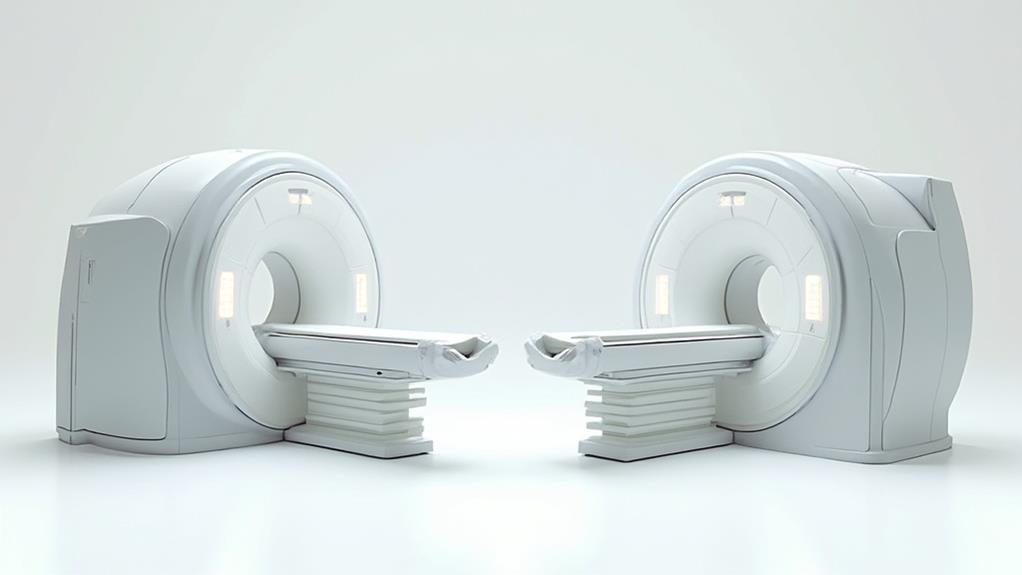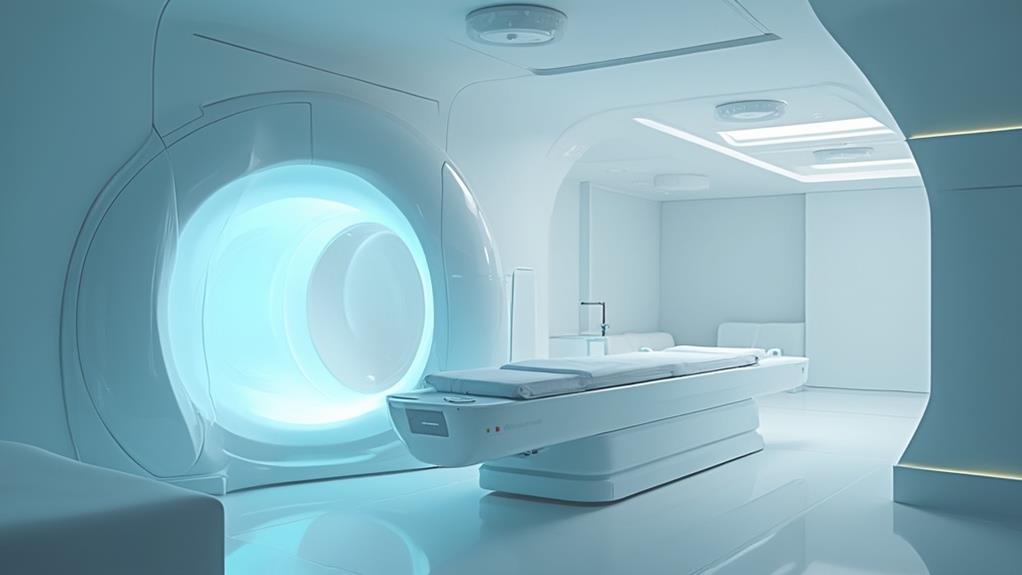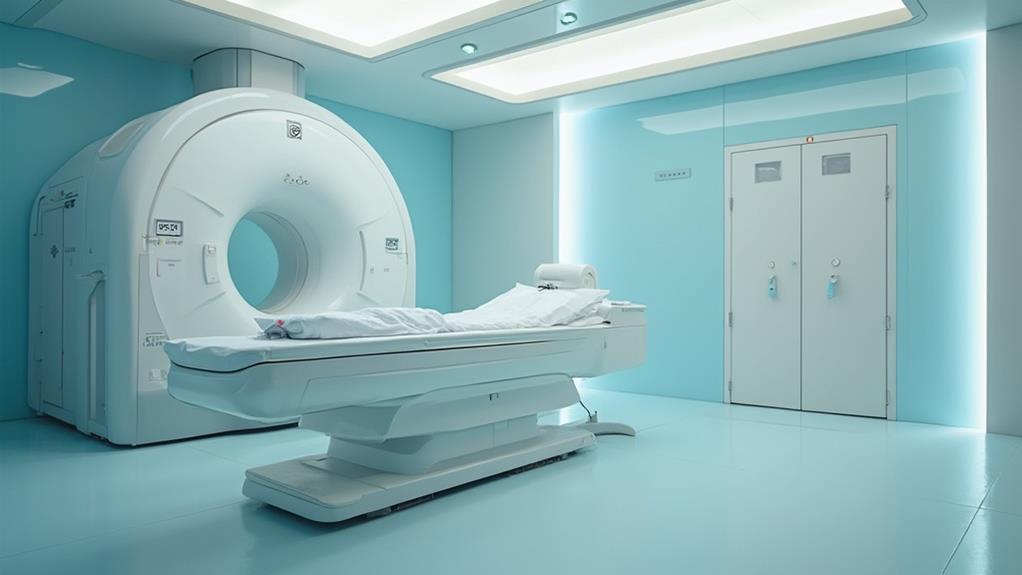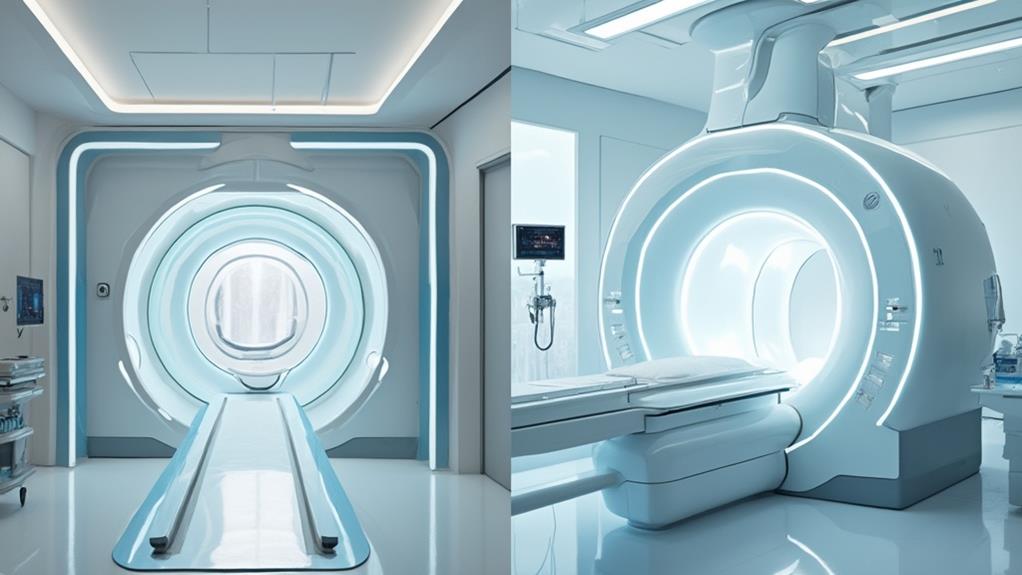Open MRI and closed MRI differ primarily in structure and patient experience. Open MRI uses a spacious, open-sided design that enhances comfort, especially for claustrophobic or larger patients. However, it typically provides lower-resolution images due to weaker magnetic fields. Closed MRI, with its cylindrical, enclosed design, allows for higher magnetic field strength, resulting in more detailed images, but may cause discomfort for some patients due to its confined space. While closed MRI excels in image clarity, open MRI prioritizes patient comfort and accessibility. Each type has distinct advantages depending on the clinical scenario, patient needs, and comfort levels.
MRI Highlights
- Closed MRI offers higher-resolution images due to stronger magnetic fields.
- Open MRI provides enhanced comfort, especially for claustrophobic or obese patients.
- Closed MRI's confined space may cause anxiety or discomfort for some patients.
- Open MRI allows a wider range of scanning positions and better patient visibility.
- Closed MRI machines produce louder noise compared to quieter open MRI devices.
Overview of MRI Types

Magnetic Resonance Imaging (MRI) is a vital diagnostic tool used to visualize detailed internal structures, distinguished into two primary types: open MRI and closed MRI. Both types serve the same purpose—providing clear images of organs and tissues—but differ considerably in their structural designs.
Each has its own set of advantages and disadvantages, impacting patient experience and image quality. Open MRI is often preferred for claustrophobic patients because it uses an open design that reduces feelings of enclosure. Conversely, closed MRI traditionally offers higher-resolution images, which can be particularly beneficial for detailed diagnostic requirements.
Definition and Purpose
In the domain of medical imaging, defining the different types of MRI machines is essential for understanding their respective applications and advantages. Magnetic Resonance Imaging (MRI) employs powerful magnets and radio waves to create detailed images of the body's internal structures. There are primarily two types of MRI: open and closed.
A closed MRI is the traditional, cylindrical machine where a patient lies within a narrow tube surrounded by a magnet. This type is highly effective in producing high-resolution images, beneficial for detailed assessments of tissues and organs. It is frequently utilized for diagnosing complex conditions, such as tumors, brain disorders, and musculoskeletal injuries.
In contrast, an open MRI features a wider, more open design, allowing more comfort for patients who may suffer from claustrophobia or obesity. While the image quality can be slightly lower than that of a closed MRI, advancements in technology have considerably reduced this gap. The open design is particularly advantageous for pediatric patients or those needing additional assistance during the scan.
Selecting the appropriate machine for their patients' needs, providers can ensure both comfort and diagnostic precision. This knowledge fosters more informed decisions in patient care.
Structural Differences
Understanding the structural differences between open and closed MRI machines is key to appreciating their distinct functionalities and patient applications. Closed MRI machines encompass a cylindrical design with a tube-like structure where patients are slid into the magnetic field. This configuration allows for high-strength magnetic fields and typically leads to more detailed and higher resolution images, ideal for intricate diagnostic needs.
In contrast, open MRI machines feature a more open-sided design, providing greater comfort for patients, especially those who experience claustrophobia, suffer from obesity, or require frequent communication with the technologist during the procedure. The lack of a surrounding tube in open MRI models can foster a less intimidating environment, which is beneficial for pediatric or anxious patients.
The essential distinction lies in the physical construction—where closed MRIs offer a compact and sealed imaging environment; open MRIs provide a space-conscious alternative without compromising the diagnostic capabilities for a range of conditions. Both types use powerful magnets and radio waves, but the specific structural setup can directly affect the image acquisition process and patient experience. As a result, a detailed understanding of these machines' physical differences enables better decision-making in selecting the most appropriate MRI type for patient care.
Advantages and Disadvantages
Choosing between open and closed MRI types involves evaluating the inherent advantages and disadvantages associated with each. Closed MRIs are traditionally known for their superior image quality. The enclosed structure allows for higher magnetic field strength, which results in clearer and more detailed images. This precision is essential for diagnosing intricate conditions.
However, the confined space of a closed MRI may cause discomfort or anxiety in some patients, particularly those with claustrophobia.
Conversely, open MRIs provide a more comfortable experience for patients. The open design reduces feelings of confinement, making it a preferable choice for individuals with anxiety or children. Additionally, open MRIs are more accommodating for patients with larger body types, ensuring accessibility for a wider range of individuals.
However, the trade-off lies in image resolution. Open MRIs typically have lower magnetic field strength, which can result in less detailed images compared to closed MRIs.
Benefits

The benefits of open MRI systems are significant and multifaceted. Patients often experience enhanced comfort and reduced claustrophobia risks, which can be particularly important for those with anxiety or mobility issues.
Additionally, the versatility in scanning positions available with open MRI contributes to an improved imaging experience, making it a valuable option in various medical scenarios. Open MRI systems are also helpful for patients who need noninvasive evaluation of diseases or injuries without surgery.
This versatility allows for a more accommodating approach, especially for those who may have difficulty remaining still or have specific health concerns.
Enhanced Patient Comfort
Many patients experience notable anxiety and discomfort when faced with the prospect of undergoing an MRI scan. Open MRI technology offers a remedy by meaningfully enhancing patient comfort.
Unlike traditional closed MRI machines, open MRI units utilize a more spacious design, which accommodates various body sizes and patient positioning requirements, leading to a more positive overall experience.
Enhanced comfort is particularly beneficial for several patient groups:
- Children and Elderly: The more open structure of the machine can help alleviate fear and distress in both younger and older patients.
- Patients with Mobility Issues: The open layout facilitates easier positioning and reduces the physical strain associated with entering and remaining still inside a traditional closed MRI machine.
- Longer Examination Periods: Open MRI machines are less confining, making it easier for patients to remain calm and comfortable throughout prolonged scans.
Reduced Claustrophobia Risks
In addition to enhanced patient comfort, another contextually relevant advantage of open MRI machines is the substantial reduction in claustrophobia risks. Claustrophobia, an intense fear of confined spaces, is a common concern among patients required to undergo MRI scanning. This fear can lead to anxiety and, in extreme cases, the inability to complete the procedure. Open MRI machines, with their spacious design and open sides, markedly mitigate this issue by providing a less confining environment.
The reduced sense of enclosure in an open MRI eases patients' anxiety, making the experience more tolerable for those who might otherwise avoid essential diagnostic tests. Children, elderly individuals, or patients with mobility issues also benefit greatly, as the open configuration facilitates easier positioning and monitoring. For healthcare providers committed to serving others, these machines represent a valuable tool to guarantee patients receive timely and accurate diagnoses without unnecessary stress.
Furthermore, the open design allows for parental or caregiver presence during the scan, which can be particularly comforting for pediatric and anxiety-prone patients. This direct observation opportunity underscores the commitment to patient-centered care, enhancing the overall treatment experience and fostering a supportive environment for all involved.
Improved Imaging Experience
Opting for open MRI machines often provides an enhanced imaging experience, inherently shaped by their patient-friendly design. The architecture of open MRI machines is noticeably different from that of traditional closed units. This difference not only reduces the feeling of confinement but also enhances overall patient comfort during the scanning process.
The benefits of opting for an open MRI include:
- Enhanced Visibility: Patients can see their surroundings more clearly, decreasing anxiety, and promoting a sense of calm. This feature is particularly advantageous for pediatric and elderly patients who may feel overwhelmed by traditional enclosed MRI environments.
- Increased Comfort: The wider design allows for a more relaxed positioning, which can be particularly beneficial for those with conditions such as chronic pain or limited mobility. The ability to maintain a comfortable position helps to reduce discomfort and ensures a more pleasant experience.
- Flexibility for Support: Open MRI machines allow for the presence of a companion or assistant during the scan. This can be crucial for patients who require emotional or physical support, enhancing their overall comfort and trust in the medical process.
These key advantages demonstrate how open MRI machines can vastly improve the imaging experience, making it more patient-centric and accessible for diverse population segments.
Versatility in Scanning
One of the paramount benefits of open MRI machines is their exceptional versatility in scanning various parts of the body. Unlike traditional closed MRI systems, open MRI devices offer a broader range of positioning options due to their design. This flexibility is particularly advantageous for imaging joints, such as shoulders and knees, where specific angles may be required to capture detailed images.
Patients with movement disorders, who might struggle to remain still in a closed MRI, can also benefit from the more accommodating nature of an open MRI.
Open MRI systems are also ideal for scanning larger or claustrophobic patients who may find the enclosed space of a traditional MRI machine uncomfortable. The open design reduces feelings of confinement, which can enhance patient cooperation and ultimately lead to more accurate results. Additionally, the ease of access provided by open MRI machines allows healthcare providers to perform scans on young children or elderly patients with minimal stress or difficulty.
Patient Comfort Comparison

Patient comfort is a vital factor when choosing between an open MRI and a closed MRI. Key differences include the anxiety experienced in enclosed spaces, the noise level during scanning, and overall comfort throughout the procedure. The table below summarizes these aspects:
| Factor | Open MRI | Closed MRI |
|---|---|---|
| Enclosed Space Anxiety | Lower | Higher |
| Noise Level | Quieter | Louder |
| Comfort During Scan | More Spacious | More Confining |
These elements play a significant role in determining which type of MRI might be more suitable for different patient needs.
Enclosed Space Anxiety
Patients undergoing MRI scans often confront major challenges related to enclosed space anxiety, a factor that heavily influences their overall comfort and willingness to undergo the procedure. This anxiety stems primarily from the tight, confined environment characteristic of traditional closed MRI machines. Such conditions may provoke feelings of claustrophobia, which can be quite distressing for patients.
Open MRI machines offer an alternative that can greatly alleviate these concerns. Unlike closed MRIs, open MRIs feature a more spacious design, which can lessen the sensation of being trapped and enhance patient comfort. Key benefits include:
- Increased Visibility: Patients can see their surroundings, reducing feelings of confinement.
- Better Airflow: The open design allows for improved ventilation, which can make the experience more pleasant.
- Flexibility in Positioning: Open MRIs often enable more comfortable positioning, which is advantageous for individuals with mobility issues or chronic pain.
For healthcare providers aiming to serve a patient-centered approach, understanding and addressing enclosed space anxiety is essential. Offering options such as open MRI can enormously improve the patient experience, making the procedure more accessible and less intimidating. This awareness can contribute to higher patient satisfaction and better overall health outcomes.
Noise Level Differences
Auditory comfort, a considerable aspect of the patient experience during MRI scans, varies distinctly between open and closed MRI machines. Closed MRI machines, known for their cylindrical structure, often produce louder noise during scanning due to the confined space and acoustic reflections. The rapid switching of magnetic fields, intrinsic to the function of MRI scanners, generates sounds that can reach up to 120 decibels, comparable to a rock concert or a chainsaw. Patients within these machines are therefore subjected to intense noise levels that can lead to discomfort and anxiety.
In contrast, open MRI machines generally produce lower noise levels. Their design, characterized by a more open structure, allows sound waves to dissipate more efficiently, reducing the intensity of noise that patients experience. While the sounds may still be noticeable and occasionally disruptive, the open design mitigates the impact, contributing greatly to patient comfort. Ear protection, such as earplugs or headphones, is commonly provided in both types of MRI settings to further alleviate the auditory discomfort. By understanding these noise level differences, healthcare providers can better tailor their approach to ensuring a more comfortable experience for patients undergoing MRI scans.
Comfort During Scan**
Understanding the noise level differences between open and closed MRI machines helps lay the groundwork for examining broader aspects of patient comfort during scans. Patient comfort is pivotal in ensuring a successful MRI experience and can greatly affect the quality of the diagnostic images obtained.
Open MRI machines, due to their design, often provide a less claustrophobic experience. The open architecture allows patients to see outside the machine, which can particularly benefit individuals who suffer from anxiety or claustrophobia. Additionally, this design permits parents to stay with their children during the scan, which can noticeably reduce the child's stress and facilitate smoother scanning procedures.
In contrast, closed MRI machines, which encase patients more fully, often heighten feelings of confinement. This can cause considerable discomfort for some patients, leading to movement that can compromise image quality.
Several factors contribute to patients' comfort during MRI scans, including:
- Space and Accessibility: Open MRI machines offer more room, accommodating patients with larger body types and those with mobility issues more comfortably.
- Visibility: The open design diminishes the sensation of being enclosed, which can ease mental discomfort for many.
- Support Presence: Open MRIs allow for the physical presence of a family member or caregiver, providing emotional support.
MRI FAQ
How Long Does a Typical Open MRI Scan Take?
A typical open MRI scan generally takes between 30 to 60 minutes. Factors influencing the duration include the specific area being examined and the need for any additional imaging sequences to provide thorough diagnostic information.
Can Open MRIS Provide the Same Image Quality as Closed MRIS?
The image quality of an MRI can markedly impact diagnosis and treatment. Open MRIs, while more comfortable for patients, generally offer lower image quality and resolution compared to closed MRIs, potentially affecting diagnostic accuracy.
Are There Any Specific Conditions Where a Closed MRI Is Preferred Over an Open MRI?
Closed MRIs are preferred for conditions requiring high-resolution imaging, such as detailed brain scans or small joint assessments, due to their stronger magnetic fields and higher image quality, ensuring accurate diagnoses and better patient care.
How Do Costs Compare Between Open MRI and Closed MRI Scans?
The costs of MRI scans may vary considerably due to factors such as equipment type, facility location, and insurance coverage. It is advisable to consult with healthcare providers for detailed information specific to individual diagnostic needs.
Is Special Preparation Required for an Open MRI Scan?
Special preparation for an MRI scan generally follows standard protocols: patients should remove metal objects, fast if instructed, and inform the technician of any implants or health conditions. Each facility offers detailed instructions to guarantee optimal patient care and safety.
